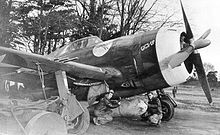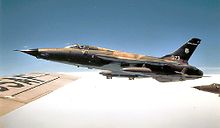113th Operations Group
The group's primary mission is training of air combat and operational airlift crews for national defense.
Members of the group also assist local and federal law enforcement agencies in combating drug trafficking in the District of Columbia on a case-by-case basis.
It performed a variety of missions for the Eighth Air Force, but predominantly served as bomber escort.
Once aircraft were received and pilots proficient, the squadrons were assigned to alert duty over New York City, operating from LaGuardia Airport where pilots often performed acrobatic maneuvers on takeover much to chagrin of the tower, routinely buzzed Yankee Stadium and engaged in dogfights over the city thereby garnering attention of authorities.
Training was in its advanced phase when the group was reassembled at Westover in late May in anticipation of deployment orders.
The order to deploy arrived in June and the group moved to Camp Kilmer, New Jersey to prepare to embark aboard the ocean liner RMS Queen Elizabeth, leaving on 1 July 1943 for Scotland and service with the Eighth Air Force.
Skirmishes with the Luftwaffe were frequent, but it wasn't until 26 November when Major John C. Meyer of the 487th Squadron scored the group's first victory over Europe, a Messerschmitt Bf 109 fighter.
Notable pilots of the 352d include top scoring P-51 aces Major George Preddy and Col. John C. Meyer, Capt.
In December 1944, the 352d received orders to deploy to Asch Airfield, a remote field approximately 3 miles south-southeast of As, Belgium.
Although he did not get permission until 0800, he joined the 487th Fighter Squadron in the frigid cold of the snowy weather at 0530 preflighting their Mustangs and was sitting in the cockpit of the lead aircraft.
However, one pilot, Lt. Dean Huston, was forced to belly land his P-51 after its cooling system was holed from the fire of zealous British antiaircraft gunners.
During the afternoon of the same day, fighters of the 328th Squadron were patrolling the skies above As when they spotted what they thought were four inbound enemy aircraft.
The group remained in England after V-E Day until November, when it returned to the United States and was inactivated at the New York Port of Embarkation.
With the surprise invasion of South Korea on 25 June 1950, and the regular military's lack of readiness, most of the Air National Guard was federalized placed on active duty.
Once it completed its conversion to Thunderjets, the 148th moved to Dover Air Force Base, Delaware[4] In September and October 1951 the group converted to Lockheed F-94B Starfires with partial all-weather capabilities.
In January 1968 the Pueblo Crisis by North Korean forces brought the callup of the 113th to active duty.
At Myrtle Beach the group was a paper unit, with its squadron assigned directly to the 113th Wing under the dual deputy organization used by TAC.
[note 9] The group returned to Andrews in June 1969, and transitioned into the Republic F-105D Thunderchief, which was beginning to be withdrawn from the active inventory.
− This article incorporates public domain material from the Air Force Historical Research Agency







